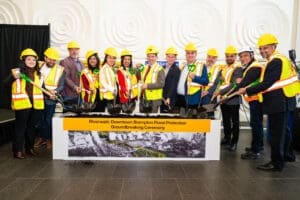Transitioning a city from a car-centric culture to one that prioritizes safety, the environment, affordability, and health is not new. Cities around the province, country, and world—like Toronto, Guelph, Montreal, Amsterdam, Paris, and London—have successfully built their active transportation networks, moving away from car-dominant cities and achieving a higher quality of life. Brampton has been following their lead.
In a move towards more affordable options for people to get around the city, and a greener, healthier future, Brampton is building its active transportation network. With the endorsement of the Active Transportation Master Plan in 2019, Brampton aims to create a connected network of cycling, micro-mobility, and pedestrian infrastructure. Together with transit investments, we are providing more sustainable and affordable choices for people to get around.
The AT network further enhances safety and promotes a healthier lifestyle by encouraging residents to move differently and rely less on their cars for shorter trips, like to schools or recreation centres, and even longer trips to major employers like Amazon or major retail plazas.
Brampton’s Active Transportation Master Plan upholds Vision Zero principles to prioritize the safety of vulnerable users of the infrastructure. It’s a “Streets for People” and “Complete Streets” approach that has been proven to enhance quality of life, reduce traffic congestion, and promote healthier community interaction, similar to how other forward-thinking cities have reshaped their urban landscapes.
Importantly, it provides a crucial alternative for individuals who cannot afford cars, making transportation more accessible and affordable. Active transportation—walking, cycling, and micro-mobility—offers a cost-effective way to commute while incorporating physical activity into daily routines, addressing both economic and health needs.
With dedicated bike lanes, buffered lanes, prioritizing shared roads, reducing speeds, and pedestrian-friendly infrastructure, Brampton is reshaping its streetscape to accommodate various modes of transportation safely and efficiently. To know more about it, visit the city cycling webpage.
The city’s approach includes implementing cycling infrastructure through innovative programs such as the Fix-it Program, which focuses on enhancing existing facilities, and the Infill Program, strategically filling gaps in the cycling network to maximize connectivity. To know more about it, click here. These efforts are part of Brampton’s broader ‘Complete Streets’ approach, integrating cycling projects into road construction and resurfacing initiatives to improve accessibility for all users.
Following regional, national, and global examples, Brampton has made significant strides in expanding its active transportation infrastructure to support a broad network. The addition of 11.9 km of cycling paths in 2022, and the implementation of 30 km more in 2023, demonstrates Brampton’s commitment to reducing carbon emissions and enhancing public health, much like London and Paris’ efforts towards a greener urban environment. Ongoing projects like the East/West Cycling Corridor Project, which connects key destinations across the city and integrates with existing north-south trails, highlight Brampton’s dedication to creating a safer and more connected network.
An active transportation network plays a critical role in addressing social and economic inequities. By providing affordable and accessible transportation options, Brampton is making it easier for low-income residents to commute to work, access essential services, and participate in community activities. This inclusivity fosters a more equitable city where everyone, regardless of their financial situation, can benefit from improved mobility and connectivity.
As other cities have experienced, the shift from a car-centric culture to one that embraces other modes of mobility is a challenge that takes time. However, aside from equity, and environmental and health benefits, building an active transportation network is a must. Given unprecedented growth, Brampton cannot sustainably grow and expect everyone to drive. Removing any options for other modes of transportation would result in more congestion and traffic as “induced demand” research suggests.













